Injuries and apparent Decline



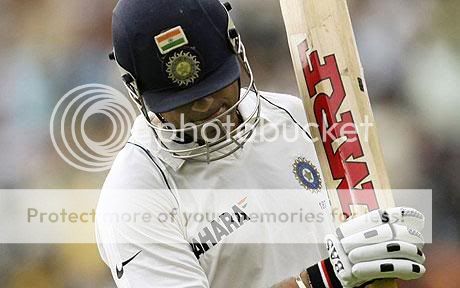
The Nervous Nineties is a commonly used term in CRICKET.
The term refers to a specific form of analysis paralysis, when a batsman feels when he has scored more than 90 runs in a test innings, and is nervous because of the pressure and desire to convert this into a century (100 runs). Therefore this situation is referred to as batsmen being in the nervous nineties. Batsmen tend to bat in a more conservative manner when they are close to their century, in order to avoid missing out on the milestone. Batsmen dismissed on 99 are considered the unluckiest of all the nervous nineties victims. There are many batsman who have been dismissed in the nineties with multiple instances of batsmen being dismissed on 99.
The opposing captain may position his fielding in order to create extra pressure to get the batsman out. As a result of this many batsmen fail to score hundreds from nineties.
Sachin Tendulkar
Indian Sachin Tendulkar holds the record for highest number of dismissals in the 90s (a total of 25 times) across all forms of international cricket. He is also the only player to have been dismissed for 99 three times in international cricket. However, he is also the highest run-scorer in international cricket history, and he has made more centuries than any other player, so the fact that Tendulkar holds the record is caused more by this fact than anything else.
Statistically, one of the worst victims of the nervous nineties was Australian opener (and now commentator)Michael Slater, dismissed in the nineties nine times in his test career, and surviving to make a century only fourteen times. West Indian batsman Alvin Kallicharan's record was similarly poor, dismissed in the nineties seven times for only twelve career centuries.
Legendary batsman Sir Donald Bradman holds the record for most test centuries scored in a career without ever being dismissed in the nervous nineties: a total of 29 centuries. Greg Chappell (24 centuries) and Michael Vaughan (18 centuries) have the next best records.
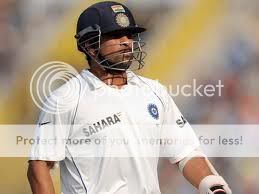

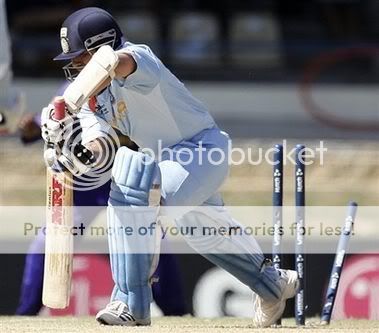
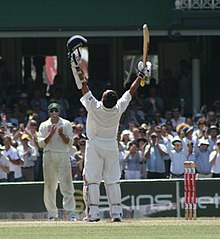
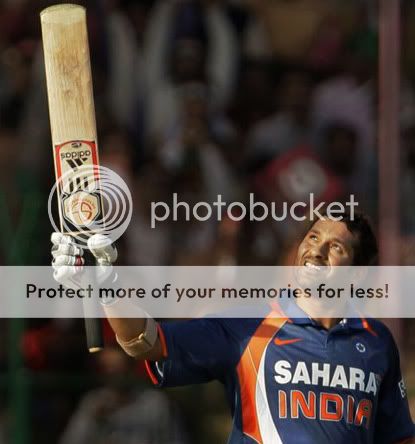
In the Border-Gavaskar Trophy, 2007–08, Tendulkar showed exceptional form, becoming the leading run scorer with 493 runs in four Tests, despite consistently failing in the second innings. Sachin scored 62 runs in the first innings of the first Test at the MCG in Melbourne, but couldn't prevent a heavy 337-run win for Australia. In the controversial New Years Test at Sydney, Tendulkar scored an unbeaten 154 as India lost the Test. This was his third century at the SCG, earning him an average of 221.33 at the ground. In the third Test at the WACA in Perth, Sachin was instrumental in India's first innings score of 330, scoring a well compiled 71, as India went on to record a historic triumph at the WACA. In the fourth Test at Adelaide, which ended in a draw, he scored 153 in the first innings, involving in a crucial 126 run stand with V.V.S. Laxman for the fifth wicket to lead India to a score of 282 for 5 from 156 for 4. He secured the Player of the Match award.
In the One-Day International Commonwealth Bank Tri-Series involving Sri Lanka and Australia, Tendulkar became the first and only batsman to complete 16,000 runs in ODIs. He achieved this feat against Sri Lanka on 5 February 2008 at Brisbane. He started the CB series well notching up scores of 10, 35, 44 and 32, but could not convert the starts into bigger scores. His form dipped a bit in the middle of the tournament, but Tendulkar came back strongly in India's must-win game against Sri Lanka at Hobart, scoring 63 off 54 balls. He finished the series with a match winning 117 not out off 120 balls in the first final,and 91 runs in the second final.

South Africa toured in March and April 2008 for a three-Test series. Tendulkar scored a five-ball duck in his only innings of the series; he sustained a groin strain in the match and as a result was forced not only to miss the second and third Tests, but also the tri-series involving Bangladesh, the 2008 Asia Cup, and the first half of the inaugural season of the IPL.
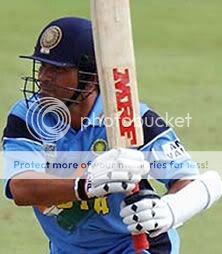
Before the three-Test series in Sri Lanka in mid-2008, Tendulkar needed just 177 runs to go past Brian Lara's record of 11,953 runs in test cricket. However, he failed in all six innings, scoring a total of just 95 runs. India lost 1–2.
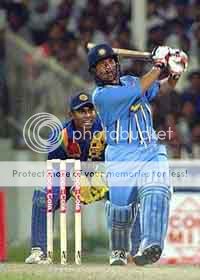
In the following ODI series against Sri Lanka, Tendulkar was sidelined due to injury. However, during the following Australia tour of India, he returned to fitness and form, scoring 13 and 49 in the first test before making 88 in the first innings of the second test, thus breaking the record for most number of Test runs held by Brian Lara. He also reached the 12,000 run mark when he was on 61. He made a fifty in the third test and 109 in the fourth, as India won the series 2–0 and regained the Border-Gavaskar Trophy.
Tendulkar was again out due to injury from the first three ODIs of a 7-match ODI series at home against England, but he made 11 in the fourth ODI and 50 in the fifth, before the ODI series was called off due to the Mumbai terror attacks, the scoreline being 5–0 to India.
England returned for a 2-match test series in December 2008, and in the first test in Chennai, chasing 387 for victory, Tendulkar made 103 not out in a 163-run unbroken fifth wicket stand with Yuvraj Singh. This was his third century in a fourth match innings, and the first which resulted in a win. This was redemption for the Chennai Test of 1999 when chasing 271 against Pakistan, Sachin had made 136 with severe back pain and was out 17 runs short of the target, precipitating a collapse and a loss by 12 runs. He dedicated this century to the victims of the Mumbai terror attacks. Tendulkar failed in both innings in the second test, India won the series 1–0.

In early 2009, India revisited Sri Lanka for five ODIs, as the Pakistan series had been cancelled due to the security situation in Pakistan and the attacks in Mumbai. Tendulkar failed to reach double figures in any inning, before becoming injured.
India's next assignment was an away series against New Zealand, consisting of three Tests and five ODIs. In the ODI series, Tendulkar made a 163 not out in the third match, an innings ended by stomach cramps that forced him to retire hurt. India made 392 and won easily and won the series 3-1. Tendulkar made 160 in the first test, his 42nd Test century, and India won. He made 49 and 64 in the second test and 62 and 9 in the third, in which India were prevented from winning by rain on the last day. India won the series 1–0.
Tendulkar rested himself for the ODI tour of West Indies, but was back for the Compaq Cup (Tri Series) between India, SL and New Zealand in early September 2009. He made 46 and 27 in the league matches before notching up 138 in the final, as India made 319 and won by 46 runs. This was Tendulkar's 6th century in ODI finals and his third consecutive score of over 50 in such finals. India has won all six times that Tendulkar has made a hundred in an ODI final.
Tendulkar played just one innings in the ICC Champions trophy in South Africa, scoring 8 againstPakistan as India lost. The next match against Australia was washed out and he was out with food poisoning in the third match against the West Indies, as India were eliminated.
Australia returned for a seven-match ODI series in India in October, and Tendulkar made 14, 4, 32 and 40 in the first four games. In the fifth match, with the series tied at 2–2, Australia amassed 350/4 in 50 overs. Tendulkar made his 45th ODI hundred, a 175 off 141 balls. Just when it seemed that he would steer India to the large victory target, he paddle-scooped debutant bowler Clint McKay straight to short fine leg, with India needing 19 from 18 balls with four wickets left. The Indian tail collapsed, and they lost by 3 runs, being all out for 347. During this match, Tendulkar also became the first player to reach 17,000 ODI runs, and achieved his personal best against Australia, as well as the third highest score in a defeat.
In the ODIs against Sri Lanka in 2009–10, Tendulkar scored 69, 43, 96 not out and 8, as India won 3–1.In the Test Series, he scored a 100 no out in the first test, which was drawn, and 40 in the second and 53 in the third test as India clinched innings victory in both tests. India won the series 2–0.
Sachin rested himself for the ODI tri series in Bangladesh in 2010. In the Tests againstBangladesh, he made 105 not out and 16 in the first test, and 143 in the second. India won 2–0.
In the 2-Test Series against South Africa, Tendulkar made seven and 100 in the first test and 106 in the first innings of the second test. In the course of the second 100 (his 47th Test Hundred) he achieved several landmarks, in that he had scored four hundreds in his last four matches and that the hundred against South Africa in the first Test was the first at home against South Africa.
The century was also his hundredth score over 50 in International Test cricket, moving him to 92 international hundreds (Tests and ODIs combined). In the subsequent ODI series, Tendulkar was run out in the first ODI for four runs, but made a strong comeback in the second match, scoring a brisk hundred off just 90 balls. This also took his tally of hundreds to 46 in ODIs and 93 in tests and ODIs combined. He finished the match on 200*, thus becoming the first batsman in the history of ODI cricket to score a double century, eclipsing Saeed Anwar's 194 against India and Charles Coventry's 194* versus Bangladesh.
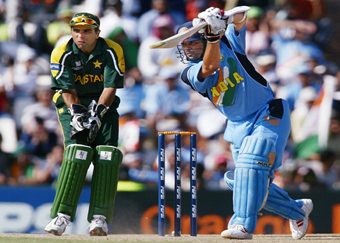
From February to April, Bangladesh, India, and Sri Lanka hosted the 2011 World Cup. Amassing 482 runs at an average of 53.55 including two centuries, Tendulkar was India's lead run-scorer for the tournament; only Tillakaratne Dilshan of Sri Lanka scored more runs in the 2011 tournament.[ India defeated Sri Lanka in the final.[ Shortly after the victory, Tendulkar commented that "Winning the World Cup is the proudest moment of my life. ... I couldn't control my tears of joy.
comment:
p_commentcount